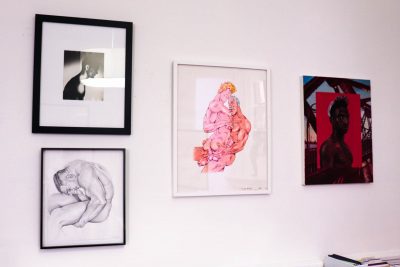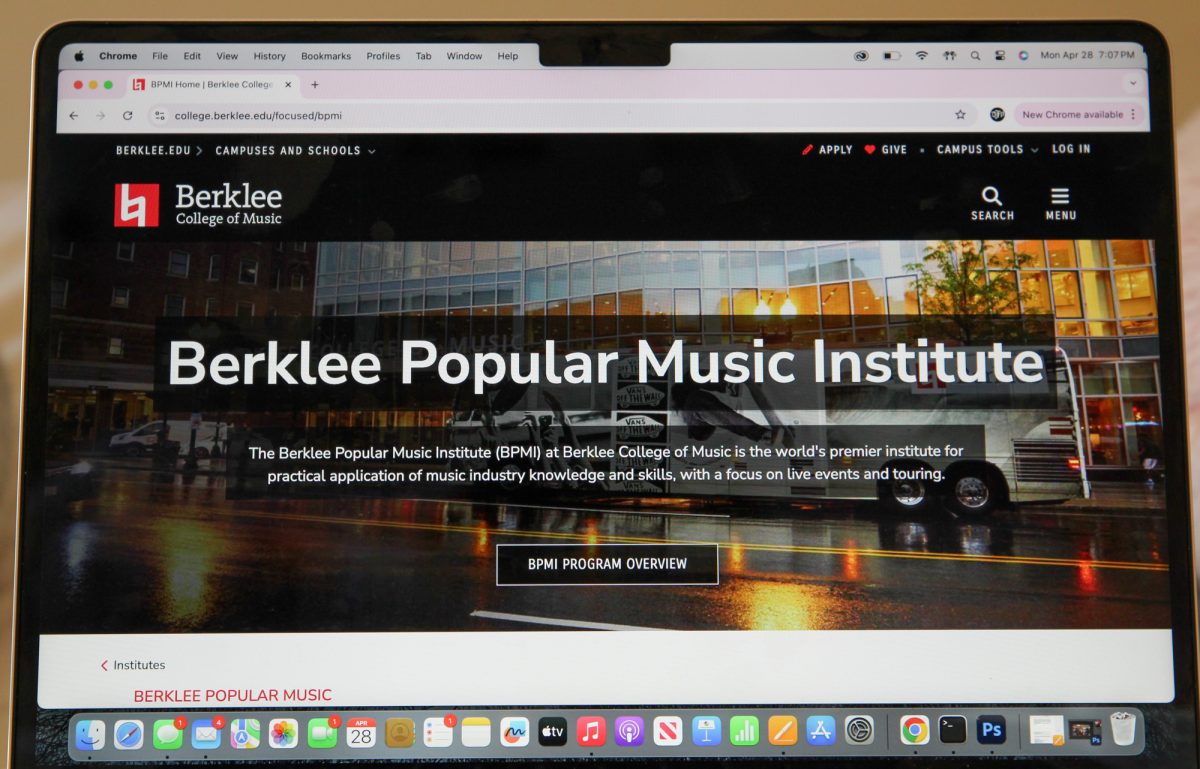The first thing you see upon entering the room is a larger-than-life depiction of a man’s face and chest — his chest tattoos barely visible, his every muscle rippling, his eyes closed, his face turned up and every detail lovingly depicted in charcoal.

That is “Kevin” by John MacConnell, one of the many works on display at Childs Gallery on Newbury Street through Nov. 6. The exhibition, “Closet to Quarantine: Queer Art Then and Now,” grew out of Gallery co-owner and President Richard Baiano’s pandemic-era Instagram feed, as he found new ways to stay in the art world while his business was closed.
“What can I do in the meantime that keeps me interested in the art?” Baiano said. “Because owning a small business that was shut down and no way of making money, I decided that I was only going to spend money directly to artists or to small businesses that were still around, so I started buying some of the artwork from some of these artists.”
He turned to social media to support up-and-coming queer artists. Through the pandemic, he bought work from contemporary artists whose work is now hanging in his gallery. Those relationships became the basis for the exhibition.
Social media has changed the art world, presenting new avenues for collaboration and exposure for artists and the people working with them. Artist Andrew Sedgwick Guth, for example, whose active Instagram feed reaches over 16,000 followers, tags his models whenever he posts a new work.
Daniel Vigil, a gay man who is a junior at the College of Fine Arts studying costume design, said social media has made it easier for aspiring artists like him to present their work.
“Social media just gives all of us a platform to be heard, even if it’s by five people or 5000, ” he said. “Social media just gives us all a place to express ourselves.”
What social media has also done, Vigil said, is help artists access communities of like-minded people with whom they can discuss their work or the world beyond.
“I think it’s definitely become easier to find the people that enjoy you,” Vigil said. “When you’re sharing art on social media, you have to be open to both sides, the people that are like-minded and the people on the complete opposite end of the spectrum.”
On the buying side, Baiano said social media has changed the art-acquisition world as well, but he still foresees a role for galleries like his in the future.
“[Social media] removes the barrier of entry to an art gallery,” he said. “[But] there’s only so much reach. While you can have 100,000 followers, it doesn’t mean you have 100,000 buyers of art.”
Baiano, a gay man, also said Childs Gallery has been “partially or wholly gay-owned since 1969” — a fact he says isn’t commonly known.
“As a result throughout its whole history we’ve acquired a number of artists that were dealing with issues relating to being gay, queer,” he said. “As a gallery, I’m interested in contemporary art that has historical references … I decided that there was quite a bit of younger queer artists out there that don’t know anything about the history of queer art.”
Many of the works in the exhibit itself are heavily influenced by social media. “Kevin” is part of MacConnell’s “Pinch Zoom” series, in which he depicts sections of male nudes as if they were zoomed-in sections of a larger picture on the phone.
“Kevin”’s scale — the piece is six feet tall — accentuates the form of the male body, but its size also points to how imposing profiles on social media can seem. MacConnell turns repeatedly to the intersection of the internet and the gay male gaze: Another work in the “Pinch Zoom” series, “Mitch,” is also part of the exhibition.
“A lot of his work has references to the internet and the iPhone,” Baiano said.
London-based artist Felipe Chavez, however, who also maintains an active social media presence, focuses on himself instead of others in his work.
“He’s his own model. He’s taking these pictures of himself in his apartment and then painting it,” said gallery assistant Wren Biszewski Eber. “If that’s not the 2020 quarantine mood, I don’t know what is.”
Chavez blends this introspection with the publicity of social media by adding detailed artist commentaries to all of his works when he posts on Instagram — “These three boys have been with me during some of my darkest, lost moments,” he writes about “Can You Hold Them As They Fall,” a piece on display at the gallery in which three nude versions of himself are depicted in intricate detail.
Baiano said he is optimistic about the future of queer art. When he started, over two decades ago, Baiano was told to never be “that ‘gay art dealer,’” he said — but now, “there is a real moment in time for [queer art].”
Vigil said that he believes as queer art continues to gain popularity, queer artists “who reject mainstream” conventions will continue to find success.
“If something that I do becomes mainstream, that will only push me to create something different and create something newer and better,” Vigil said.

























































































































